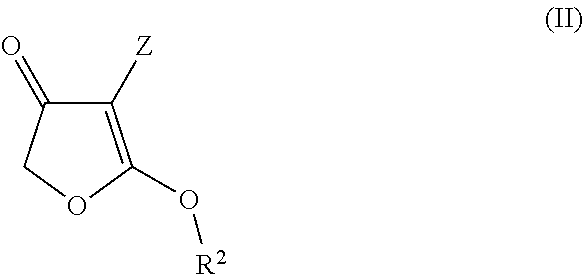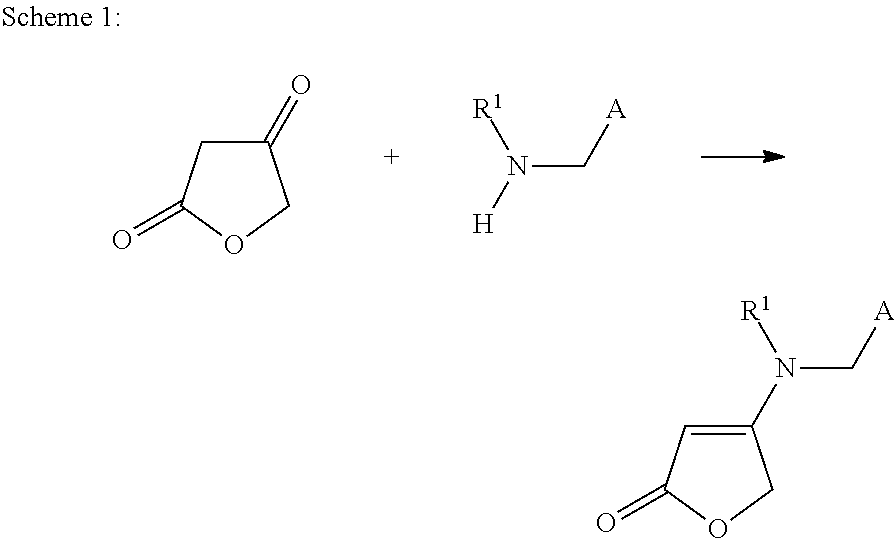Method for producing enaminocarbonyl compounds
a technology of enaminocarbonyl compounds and enaminocarbonyl compounds, which is applied in the field of process for preparing enaminocarbonyl compounds, can solve the problems of inconvenient and costly preparation, process too is not very attractive from an industrial point of view, etc., to achieve simple and inexpensive preparation, high purity, and high yield
- Summary
- Abstract
- Description
- Claims
- Application Information
AI Technical Summary
Benefits of technology
Problems solved by technology
Method used
Image
Examples
preparation examples
Example 1
Preparation of 4-[[(6-chloropyridin-3-yl)methyl](2,2-difluoroethyl)amino]furan-2(5H)-one
[0092]31.2 g of potassium hydrogensulphate are added at room temperature to a suspension of 46 g of ethyl 2-ethoxy-4,5-dihydro-4-oxofuran-3-carboxylate and 39.3 g of N-[(6-chloropyridin-3-yl)methyl]-2,2-difluoroethylamine in 705 ml of butyronitrile. The mixture was heated to reflux for 5 hours. Subsequently, it was cooled to room temperature and washed with 890 ml of water. The solvent was removed under reduced pressure. This gave 51 g of 4-[[(6-chloropyridin-3-yl)methyl](2,2-difluoroethyl)amino]furan-2(5H)-one (this corresponds to a 93% yield).
[0093]1H NMR (CDCl3, 298K) δ: 3.53 (td, 2H), 4.52 (s, 2H), 4.82 (s, 2H), 4.83 (s, 1H), 5.96 (tt, 1H), 7.37 (d, 1H), 7.55 (dd, 1H), 8.27 (d, 1H)
example 2
Preparation of isopropyl 2-isopropoxy-4,5-dihydro-4-oxofuran-3-carboxylate
[0094]20 g of diisopropyl malonate were initially charged in 173 g of toluene. Subsequently, 12 g of potassium tert-butoxide were added in portions at room temperature. After 2 hours, the solvent was removed under reduced pressure and admixed again with 173 g of toluene. At 0° C., 6 g of chloroacetyl chloride were added dropwise and the reaction mixture was then stirred at room temperature. Subsequently, 50 g of ice and 100 ml of water were added and the mixture was stirred for 10 minutes. The organic phase was removed and dried over magnesium sulphate. After the solvent had been removed, a 1:1 mixture of isopropyl 2-isopropoxy-4,5-dihydro-4-oxofuran-3-carboxylate (45% yield) and diisopropyl malonate was obtained. The mixture could be used thus in the next stage. With the aid of column chromatography, the isopropyl 2-isopropoxy-4,5-dihydro-4-oxofuran-3-carboxylate was isolated.
[0095]1H NMR (CDCl3, 298K) δ: 1.3...
example 3
Preparation of 4-[[(6-chloropyridin-3-yl)methyl](2,2-difluoroethyl)amino]furan-2(5H)-one
[0096]0.6 g of potassium hydrogensulphate was added at room temperature to a suspension of 1.0 g of isopropyl 2-isopropoxy-4,5-dihydro-4-oxofuran-3-carboxylate and 0.85 g of N-[(6-chloropyridin-3-yl)methyl]-2,2-difluoroethylamine in 15.8 g of butyronitrile. The mixture was heated to reflux for 5 hours. Subsequently, it was cooled to room temperature and washed with 10 ml of water. The solvent was removed under reduced pressure. This gave 1 g of 4-[[(6-chloropyridin-3-yl)methyl](2,2-difluoroethyl)amino]furan-2(5H)-one (this corresponds to 95% yield).
[0097]1H NMR (CDCl3, 298K) δ: 3.53 (td, 2H), 4.52 (s, 2H), 4.82 (s, 2H), 4.83 (s, 1H), 5.96 (tt, 1H), 7.37 (d, 1H), 7.55 (dd, 1H), 8.27 (d, 1H)
PUM
| Property | Measurement | Unit |
|---|---|---|
| temperature | aaaaa | aaaaa |
| molar ratio | aaaaa | aaaaa |
| boiling points | aaaaa | aaaaa |
Abstract
Description
Claims
Application Information
 Login to View More
Login to View More - R&D
- Intellectual Property
- Life Sciences
- Materials
- Tech Scout
- Unparalleled Data Quality
- Higher Quality Content
- 60% Fewer Hallucinations
Browse by: Latest US Patents, China's latest patents, Technical Efficacy Thesaurus, Application Domain, Technology Topic, Popular Technical Reports.
© 2025 PatSnap. All rights reserved.Legal|Privacy policy|Modern Slavery Act Transparency Statement|Sitemap|About US| Contact US: help@patsnap.com



